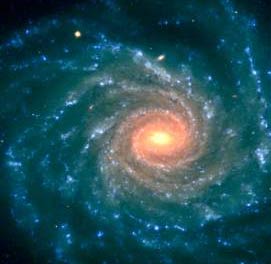Basic constants are almost constant
The idea of actual fundamental constants is not constant in space and time has long haunted physicists' minds. But by monitoring how a distant galaxy absorbs light from a Quassar, Australian physicists have obtained a new limit in determining a fundamental constant - the mass ratio between electrons and proton - how much it changes over time. Their results, with 10 times the accuracy of previous measurements, are consistent with contemporary Physics insights.
The basic constants have been precisely calibrated for our existence - if, for example, the force of interaction is more than 1% stronger than it is today, carbon cannot be produced in stars, and So all of them

Is astronomy turned upside down when constants are no longer constants?(Photo: VLVN)
I was not here. That's why many physicists are eagerly testing whether basic constants change with the age of the universe.
The basic constant as mentioned above is the ratio between the mass of an electron and a proton, m. Traditionally, it was measured by analyzing the data from a ground telescope set toward a quasar - a small but very bright nucleus of a young galaxy, often used as a lamp. sign in distant space. The spectrum of light from the quintessential to a wide range of wavelengths, but some of the wavelengths in this band can be absorbed by molecules on older galaxies that it encounters during traveling around the Universe cylinder. These wavelengths, called absorption lines, correspond to the molecular jump to higher energy levels or vibrations, and are governed by constants.
Because light from quasars takes billions of years to reach the earth, the value of m measured from a very distant source can be compared to the measured m value in the laboratory, to see if this constant is replaced. change over time. But now, Victor Flambaum and Michael Kozlov at the University of New South Wales Australia have created a much more precise method by combining ' reverse spectrum ' analysis - the spectrum formed when atoms in the molecule are absorbed. light - with quantum tunneling to higher energy levels. Because the probability of tunneling is highly dependent on the absorption lines in the rotation spectrum, this allows any time change of the range to be more accurately calculated.
Flambaum and Kozlov took data from the Effelsberg radio observatory in Germany, the data of light transmitted from a galactic quasar B0218 + 357 to 6.5 billion light-years from Earth. Then analyze both the inverse spectrum of ammonia molecules and rotational absorption of other molecules such as CO (carbon monoxide) in the data. Then compare with the corresponding spectra in the laboratory. They found that m cannot be reduced by more than 4 x 10-16 a year, and cannot increase by more than 2 x 10-16 per year - this is a 10 times more accurate assessment of the most accurate assessments ever. now on.

Victor Flambaum and Michael Kozlov at the University of New South Wales Australia used light from a quasar (pictured above) to show that one of the fundamental constants - the ratio between the mass of the electron and proton - is hardly any variable in the historical capacity of the universe (Photo: NASA)
Last year, a group led by Wim Ubachs at VU University in Amsterdam, using the old technology, said that it could decrease over time. If that is true, it means that most fundamental physics theories, like Einstein's theory of gravity, need to be reconsidered. However, Flambaum told Physics Web, his more accurate results indicate that it is unlikely to be altered, so our current understanding of Physics is fine. Moreover, he added that if more data were collated, his analysis could allow the m's change to be much more accurate.
- How big is the universe?
- The Kilogram unit is about to be redefined
- The basic knowledge is wrong, but many people still believe it
- Official: 1 kilogram is no longer 1 kilogram, and so are 3 other basic quantities
- Precise definition of temperature unit (Kelvin) thanks to laser spectroscopy techniques
- Calculated 10,000 billion digits of Pi number
- Google introduces a basic AI learning and learning website
- Discover the basic component of life in comets
- Cosmic expansion: Einstein's black energy and cosmological constant
- We have heard that acid rain is much, so what about basic rain?
- TCP and IP options
- Vietnam expects 3 bio-economic projects with the Netherlands
 Van Allen's belt and evidence that the Apollo 11 mission to the Moon was myth
Van Allen's belt and evidence that the Apollo 11 mission to the Moon was myth The levels of civilization in the universe (Kardashev scale)
The levels of civilization in the universe (Kardashev scale) Today Mars, the sun and the Earth are aligned
Today Mars, the sun and the Earth are aligned The Amazon owner announced a secret plan to build a space base for thousands of people
The Amazon owner announced a secret plan to build a space base for thousands of people